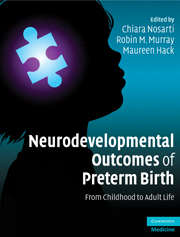Book contents
- Frontmatter
- Contents
- List of contributors
- Preface
- Section 1 Introduction
- Section 2 Neuroimaging
- 4 Imaging the preterm brain
- 5 Structural magnetic resonance imaging
- 6 Magnetic resonance imaging findings from adolescence to adulthood
- 7 Functional neuroimaging following very preterm birth
- 8 Diffusion tensor imaging findings in preterm and low birth weight populations
- Section 3 Behavioral outcome
- Section 4 Neuropsychological outcome
- Section 5 Applied research
- Section 6 Conclusions
- Index
6 - Magnetic resonance imaging findings from adolescence to adulthood
from Section 2 - Neuroimaging
Published online by Cambridge University Press: 06 July 2010
- Frontmatter
- Contents
- List of contributors
- Preface
- Section 1 Introduction
- Section 2 Neuroimaging
- 4 Imaging the preterm brain
- 5 Structural magnetic resonance imaging
- 6 Magnetic resonance imaging findings from adolescence to adulthood
- 7 Functional neuroimaging following very preterm birth
- 8 Diffusion tensor imaging findings in preterm and low birth weight populations
- Section 3 Behavioral outcome
- Section 4 Neuropsychological outcome
- Section 5 Applied research
- Section 6 Conclusions
- Index
Summary
Introduction
As has been demonstrated elsewhere in this volume, preterm birth and/or low birth weight is common, possibly increasing and associated with adverse consequences [1]. Magnetic resonance imaging (MRI) studies in childhood have done an excellent job of relating the cognitive, behavioral, and academic problems faced by preterm and low birth weight individuals to underlying alterations of brain structure, as described in Chapter 5. However, a largely unanswered question is what happens to these individuals, and to their brains, as they grow up. This lack of information is not because preterm researchers have been idle, of course, but rather because the phenomenon of widespread survival after short gestation is historically quite recent. As cohorts of prematurely born people are now becoming adults, there is now a pressing need to determine their adult outcomes. Do impairments become attenuated, persist, or worsen? How are the usual processes of development and maturation altered by preexisting structural brain abnormalities? Is neural plasticity part of the problem, as well as a potential solution? What happens to the ageing preterm brain? Many of these questions are yet to be addressed, but in this chapter we will describe some imaging studies that are starting to bridge the gap between adolescence and adulthood. In this, we will be helped considerably by recent studies which have used MRI techniques to investigate normal adolescent brain development, and which will give us a baseline for understanding changes in the preterm brain.
- Type
- Chapter
- Information
- Neurodevelopmental Outcomes of Preterm BirthFrom Childhood to Adult Life, pp. 68 - 75Publisher: Cambridge University PressPrint publication year: 2010



